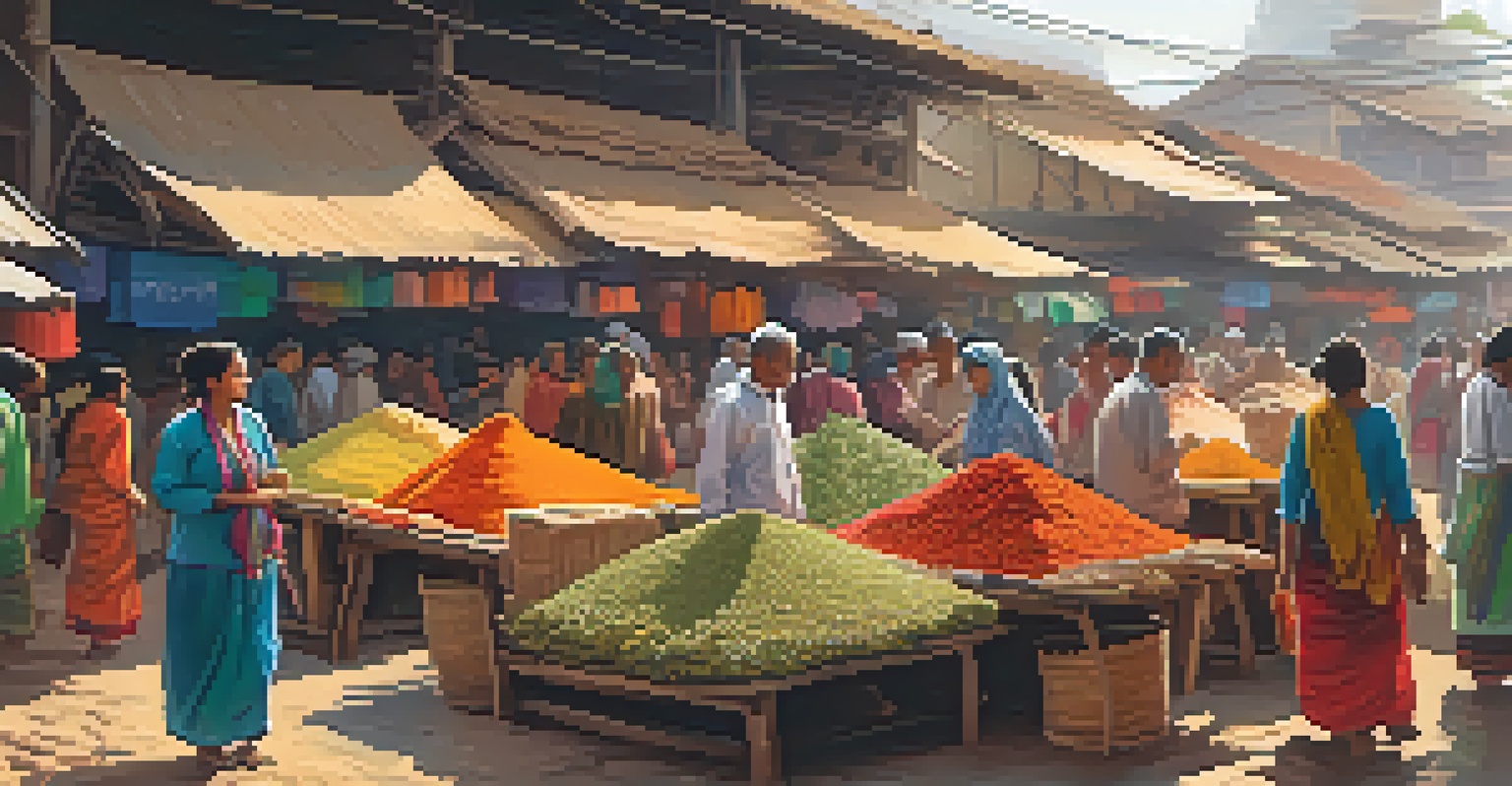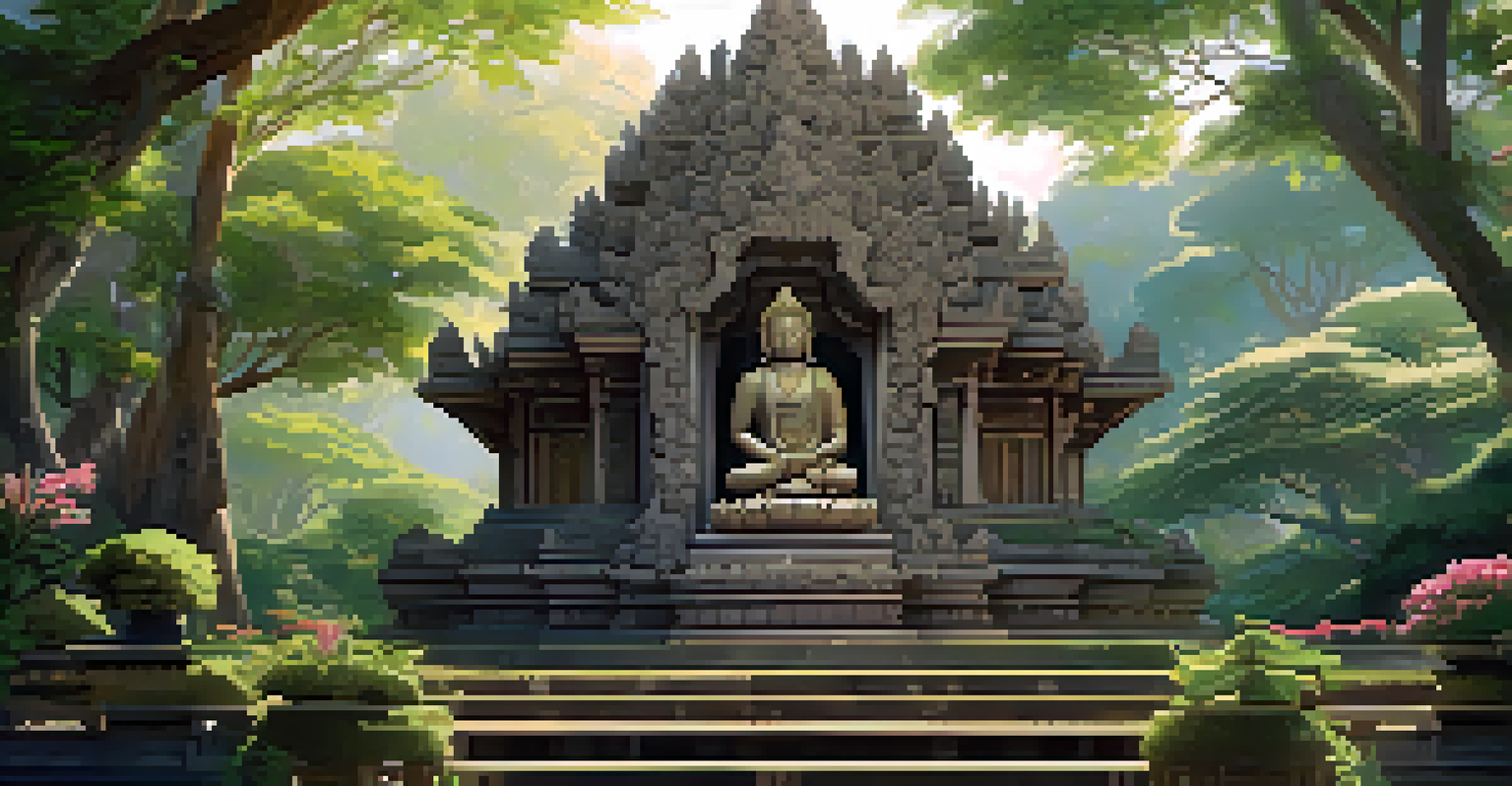The Mon Kingdom: Early Influences on Thai Language and Art

The Origins of the Mon Kingdom in Southeast Asia
The Mon Kingdom, one of the earliest civilizations in Southeast Asia, flourished around the 6th century CE. Situated in present-day Myanmar and Thailand, the Mon people established a rich cultural heritage that influenced neighboring regions. Their early settlements played a crucial role in shaping the socio-political landscape of Southeast Asia, laying the groundwork for future kingdoms, including the Thai.
Culture is the widening of the mind and of the spirit.
As traders and scholars, the Mon facilitated cultural exchanges with various civilizations, introducing new ideas and practices. This cross-pollination of cultures significantly impacted the development of local languages and artistic expressions. The Mon's interactions with Indian culture, in particular, introduced elements of religion and philosophy that would later permeate Thai society.
Today, the legacy of the Mon Kingdom can still be seen in various aspects of Thai culture, from language to traditional art forms. Understanding the Mon's origins helps to appreciate the foundation of what would evolve into the diverse tapestry of Thai identity.
The Influence of Mon Language on Thai Vocabulary
The Mon language, part of the Mon-Khmer language family, has left a lasting mark on the Thai language. Many Thai words, particularly in the realms of agriculture, everyday life, and religious practices, are derived from Mon. This linguistic influence reflects the historical interactions and exchanges between the Mon and the Thai people over centuries.

For example, words related to rice cultivation, such as 'khao' (rice), can be traced back to Mon roots. Such examples highlight how language evolves through cultural contact, with the Mon's agricultural practices enriching Thai vocabulary. Moreover, as the Thai language developed, it absorbed various elements from Mon, enhancing its expressiveness.
Mon Kingdom's Cultural Legacy
The Mon Kingdom significantly influenced Thai culture through language, art, and religious practices, shaping the region's identity.
The blending of languages not only illustrates the Mon's influence but also signifies the shared heritage of the region. This intermingling of languages continues to be an important part of Thailand's identity, demonstrating how the Mon Kingdom's contributions are woven into the fabric of Thai culture.
Mon Artistic Traditions and Their Impact on Thai Art
Mon artistic traditions have profoundly influenced the development of Thai art, particularly in architecture and sculpture. The Mon were known for their intricate temple designs and detailed sculptures, which showcased their mastery of craftsmanship. As Thai kingdoms emerged, they adopted and adapted these artistic elements into their own cultural practices.
The beauty of the world lies in the diversity of its people.
For instance, the use of stucco and brick in temple construction, along with the depiction of Buddhist motifs, can be traced back to Mon influences. The famous Wat Phra Kaew in Bangkok, with its ornate decorations, reflects a fusion of Mon artistry and Thai aesthetics. This blending of styles symbolizes a cultural continuity that honors the Mon's contributions.
Moreover, traditional Mon festivals and rituals have also left their mark on Thai celebrations, enriching the cultural landscape. The integration of Mon artistic elements into Thai culture highlights the importance of preserving and recognizing the historical connections between these two vibrant civilizations.
Mon Religion and Its Role in Shaping Thai Spirituality
Religion played a pivotal role in the Mon Kingdom, particularly Buddhism, which became a cornerstone of their culture. The Mon were instrumental in the spread of Theravada Buddhism in Southeast Asia, influencing the religious practices of neighboring communities, including the Thais. This shared religious foundation created a strong bond between the Mon and Thai cultures.
Many Buddhist texts and teachings were translated into the Mon language, facilitating the dissemination of spiritual knowledge. These texts not only shaped the Mon's religious practices but also laid the groundwork for the Thai interpretation of Buddhism. As a result, the Thai Buddhist tradition retains elements that can be traced back to Mon influences.
Linguistic Impact on Thai Language
Many Thai words, particularly in agriculture and daily life, are derived from the Mon language, showcasing their historical interactions.
The celebration of Buddhist festivals and the establishment of monasteries in Thailand reflect this ongoing spiritual lineage. The Mon's contributions to religion have enriched Thai spirituality, underscoring the interconnectedness of Southeast Asian cultures and the enduring impact of the Mon Kingdom.
The Role of Trade in Cultural Exchange between Mon and Thai
Trade routes connecting the Mon Kingdom to other Southeast Asian regions facilitated a vibrant exchange of goods, ideas, and culture. Mon merchants were known for their extensive trade networks, which not only brought economic prosperity but also introduced new cultural elements to the Thai people. This exchange created a dynamic interaction that shaped the cultural landscape of the region.
Through trade, the Mon shared agricultural techniques, culinary practices, and artistic innovations. For instance, the introduction of certain spices and cooking methods enriched Thai cuisine, creating a unique culinary identity. Additionally, the exchange of textiles and crafts further exemplified how trade fostered cultural diversity and richness.
As trade flourished, so did the opportunities for cultural blending and mutual influence. The legacy of this exchange is still evident today, as Thailand continues to celebrate its diverse cultural heritage, shaped significantly by its historical interactions with the Mon Kingdom.
Mon Kingdom's Legacy in Modern Thai Culture
The legacy of the Mon Kingdom is not just a chapter in history; it echoes in modern Thai culture. From language to art, the influences of the Mon are woven into the very fabric of Thai identity. Festivals, traditional crafts, and even local dialects carry the essence of Mon heritage, showcasing the enduring impact of this ancient civilization.
In contemporary Thailand, efforts to preserve and promote Mon culture have gained momentum. Cultural events celebrating Mon traditions and arts are increasingly popular, allowing the younger generation to connect with their roots. This revival serves as a reminder of the rich history that continues to influence Thailand today.
Trade and Cultural Exchange
Trade routes established by the Mon facilitated a rich exchange of goods and cultural elements, further enriching Thai heritage.
Recognizing the Mon's contributions encourages a deeper understanding of Thailand's cultural diversity. It highlights the interconnectedness of cultures and the importance of honoring the past while embracing the future, ensuring the Mon Kingdom's legacy remains alive in the hearts of the Thai people.
Conclusion: Celebrating the Mon Kingdom's Influence
In conclusion, the Mon Kingdom's influence on Thai language and art is profound and multifaceted. From linguistic contributions to artistic expressions, the Mon have played a crucial role in shaping Thailand's cultural landscape. Their legacy serves as a testament to the power of cultural exchange and the interconnectedness of civilizations.
As we explore Thailand's rich history, it's essential to acknowledge the Mon's contributions and celebrate their enduring impact. By understanding the roots of Thai culture, we gain a deeper appreciation for the diverse influences that have shaped this vibrant nation. The Mon Kingdom's story is a reminder of the beauty of cultural diversity and the shared heritage that binds us all.

Ultimately, honoring the influences of the Mon Kingdom not only enriches our understanding of Thai culture but also inspires a sense of unity among different cultures. As we continue to celebrate this heritage, we pave the way for future generations to appreciate the richness of their cultural identity.